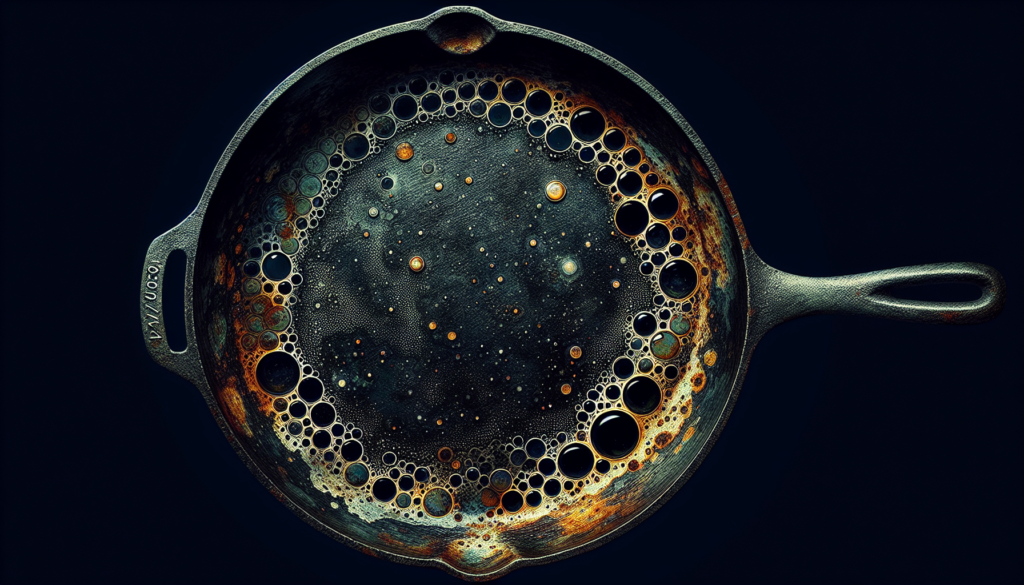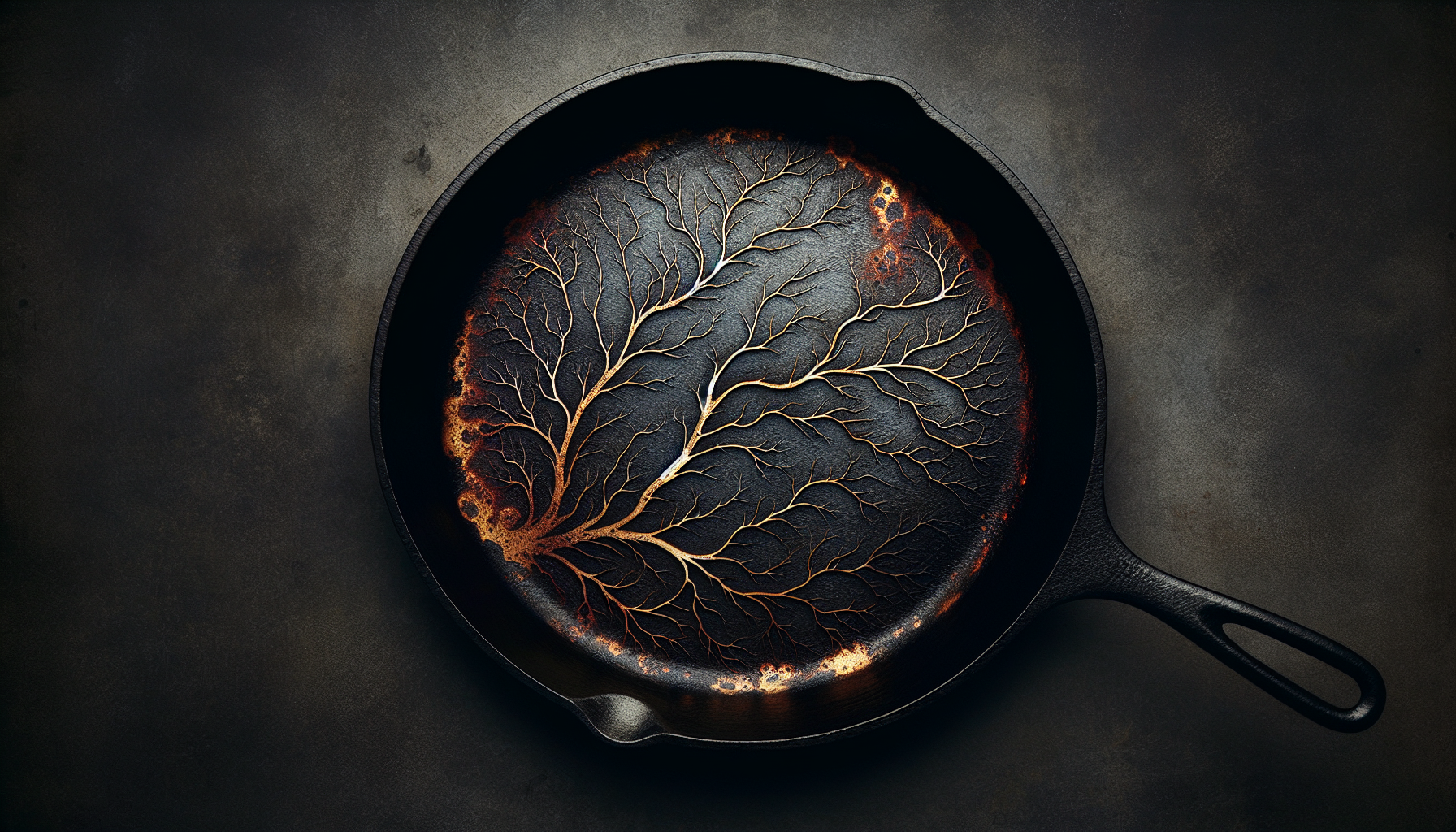Imagine cooking a delicious meal in your beloved cast iron pan, only to discover a few spots of rust on its surface. Oh no! Should you be concerned? Well, maybe not….The answer may surprise you.
In this article, we will explore whether rust on a cast iron pan poses any real danger and what steps you can take to remedy the situation. So, put on your apron and let’s dive into the world of cast iron cooking!

What Causes Rust on a Cast Iron Pan
Exposure to Water
One of the main causes of rust on a cast iron pan is exposure to water. When water comes into contact with the iron surface, it triggers a chemical reaction called oxidation. This reaction causes the iron to react with oxygen in the air, resulting in the formation of rust. If a cast iron pan is consistently exposed to water, such as when it is left wet or not properly dried after each use, the likelihood of rusting increases significantly.
Improper Seasoning
Another factor that can lead to rust on a cast iron pan is improper seasoning. Seasoning refers to the process of building up a protective layer of polymerized oil on the surface of the pan. This layer helps to prevent moisture from reaching the iron and ultimately causing rust. If a cast iron pan is not seasoned properly or if the seasoning layer becomes damaged or worn off over time, the pan becomes more susceptible to rusting.
Lack of Proper Maintenance
Lastly, a lack of proper maintenance can also contribute to the development of rust on a cast iron pan. If the pan is not regularly cleaned and seasoned, any food particles or moisture left on the surface can lead to rust formation. It is important to take the time to clean your cast iron pan after each use, dry it thoroughly, and properly season it to ensure its longevity and prevent rust from occurring.
The Nature of Rust
Chemical Composition
Rust is a reddish-brown flaky substance that forms on iron or steel surfaces that have been exposed to oxygen and moisture. Chemically, rust is a form of iron oxide, specifically ferrous oxide (Fe2O3). It is a result of the oxidation process, where iron reacts with oxygen in the presence of water or moisture. Rust is known for its porous and brittle nature, which can cause it to easily flake off and deteriorate the integrity of the cast iron surface.
Formation Process
The formation of rust begins with the presence of water on the iron surface. Water acts as a medium for the transfer of oxygen from the air to the iron. When oxygen comes into contact with the iron, it reacts with its surface, causing the production of iron oxides. These iron oxides then further react with water and oxygen to form hydrated iron oxides, which we commonly know as rust. The process of rust formation is accelerated in the presence of certain factors such as high humidity, acidic substances, or prolonged exposure to water.
***This post may contain affiliate links. That means if you click and buy, I may make a commission at no cost to you. Please see my full disclosure policy for more details.”
Health Risks Associated with Rust
Potential Ingestion of Rust
One of the risks associated with rust on a cast iron pan is the potential ingestion of rust particles. When cooking with a rusted pan, it is possible for tiny rust flakes or particles to mix with the food being prepared. While consuming a small amount of rust is generally not harmful to most individuals, ingesting large amounts of rust over time can be detrimental to health. It is important to take precautions and avoid using heavily rusted pans or pans with loose rust flakes to ensure the safety of your meals.
Microbial Growth
Rust can create a conducive environment for the growth of bacteria and other microorganisms. The porous and rough surface of rust provides a breeding ground for pathogens that can contaminate your food. This can lead to foodborne illnesses and infections. It is essential to thoroughly clean and properly maintain your cast iron pan to prevent the growth of harmful bacteria and ensure food safety.
Calphalon cookware 10-Piece Cookware review
Iron Overload
While iron is an essential mineral for the body, excessive iron intake can be harmful. Cooking with a rusted cast iron pan can potentially contribute to iron overload, especially if the rust particles are ingested with the food. Iron overload can lead to a condition called hemochromatosis, where excessive iron is stored in the body’s organs and tissues, potentially causing damage. It is crucial to prevent rust from forming on your cast iron pan to avoid any potential risk of iron overload.
Understanding Iron as a Dietary Component
Recommended Daily Intake
Iron is a vital nutrient that plays a crucial role in the body’s overall function. The recommended daily intake of iron varies depending on factors such as age, sex, and overall health. For adult males, the recommended daily intake of iron is around 8 milligrams, while adult females require approximately 18 milligrams. It is important to maintain a balanced diet that includes sources of iron to meet your body’s nutritional needs.
Calphalon cookware 10-Piece Cookware review
Iron Absorption and Metabolism
Iron absorption and metabolism is a complex process. The body absorbs iron from dietary sources differently depending on the type of iron consumed. Heme iron, which is found in animal-based foods such as meat and fish, is more easily absorbed than non-heme iron, which is found in plant-based foods. The iron absorption process can be affected by various factors such as the presence of other nutrients (e.g., vitamin C enhances iron absorption) and certain health conditions. It is important to ensure adequate intake of iron and support its absorption through a balanced and varied diet.

When Is Rust on a Cast Iron Pan Dangerous
Rusty Surface Flakes or Comes Off
If the rust on a cast iron pan has progressed to a point where it is flaking or coming off in large pieces, it is a clear indication that the pan is compromised and potentially dangerous. Rust flakes can mix with food during cooking and pose a risk of ingestion. In such cases, it is best to discontinue using the pan and consider proper rust removal and re-seasoning to restore its safety.
Frequent Cooking in Acidic Foods
Cooking acidic foods in a rusted cast iron pan can accelerate the rusting process and potentially release harmful substances into your meals. Acidic ingredients such as tomatoes, citrus fruits, or vinegar can react with the rust, causing it to deteriorate at a faster rate. It is advisable to avoid cooking acidic foods in a heavily rusted pan to ensure both food safety and the preservation of the pan’s integrity.
Presence of Sharp Rusty Edges
Sharp rusty edges on a cast iron pan can pose a physical danger, especially when handling the pan or when the rusted areas come into contact with food. These sharp edges can cause cuts or injuries, and it is important to handle the pan with caution to prevent accidents. If you notice sharp rusty edges on your pan, it is advisable to address the rust issue promptly by removing the rust and ensuring the pan’s safety.
Preventing Rust on a Cast Iron Pan
Proper Seasoning and Re-seasoning
Proper seasoning is key to preventing rust on a cast iron pan. To season a cast iron pan, coat it with a thin layer of oil and bake it in the oven at a designated temperature. This process creates a polymerized layer that acts as a protective barrier against moisture and rust. It is important to regularly re-season your cast iron pan to maintain its protective coating and ensure its longevity. Re-seasoning can be done by applying a thin layer of oil after each use and baking the pan for a short period.
Drying and Storing
Properly drying and storing your cast iron pan is essential in preventing rust formation. After each use, wash the pan with warm water and a gentle scrub brush or sponge. Thoroughly dry the pan with a towel or by placing it on a low heat source until any moisture has evaporated. Storing the pan in a clean and dry environment, such as inside a ventilated cupboard or covered with a towel, can further protect it from moisture and rust.
Avoiding Excessive Exposure to Water
Minimizing the exposure of your cast iron pan to water is crucial in preventing rust. Avoid soaking the pan in water or leaving it wet for prolonged periods. Instead, immediately dry the pan after washing, ensuring that there is no moisture remaining on the surface. Additionally, avoid using harsh or abrasive cleaning agents that can damage the seasoning or remove the protective layer of the pan.
Removing Rust from a Cast Iron Pan
Using Salt and Oil Scrub
One of the simplest methods to remove rust from a cast iron pan is by using a salt and oil scrub. Begin by coating the rusted areas with a small amount of vegetable oil. Then, sprinkle coarse salt onto the surface and use a cloth or sponge to scrub the rust gently. The combination of oil and salt works to break down and remove the rust, revealing a clean surface. Rinse the pan thoroughly, dry it completely, and proceed with the re-seasoning process to restore its protective layer.
Utilizing Baking Soda Paste
Baking soda can be effective in removing rust from a cast iron pan. Create a paste by mixing baking soda with water until it forms a thick consistency. Apply the paste to the rusted areas and let it sit for a few hours or overnight. Then, use a scrub brush or sponge to gently scrub the rusted surface. Rinse the pan thoroughly, dry it completely, and proceed with the re-seasoning process to restore its integrity.
Applying Commercial Rust Removers
There are commercial rust removers available that are specifically formulated for cast iron. These products often come in the form of gels or sprays. Follow the instructions provided by the manufacturer when using these rust removers. Generally, you will need to apply the product to the rusted areas, let it sit for a designated period, then scrub or rinse off the rust. After using a commercial rust remover, thoroughly clean and dry the pan before re-seasoning it.
Re-seasoning After Rust Removal
Cleaning the Pan
After removing rust from a cast iron pan, it is crucial to thoroughly clean the pan to remove any residue left behind by the rust removal process. Wash the pan with warm water and a gentle scrub brush or sponge, ensuring that all traces of rust and cleaning products are removed. Rinse the pan thoroughly to ensure it is clean and ready for the re-seasoning process.
Applying Oil
Once the pan is clean and dry, it is time to apply a thin layer of oil to the surface. Choose an oil with a high smoke point, such as vegetable oil or flaxseed oil. Using a cloth or paper towel, apply a small amount of oil to the entire surface of the pan, ensuring that it is evenly coated. Pay extra attention to the rusted areas to provide additional protection. Wipe off any excess oil.
Baking the Pan
To complete the re-seasoning process, heat the oiled cast iron pan in the oven. Preheat the oven to a designated temperature, usually around 375°F (190°C) to 400°F (200°C). Place the pan upside down on the top rack of the oven to allow any excess oil to drip off. Bake the pan for approximately one hour, then turn off the oven and let the pan cool down naturally. Once cooled, the pan is ready to use again with a fresh seasoning layer to protect it from rust.
Restoring an Extremely Rusty Cast Iron Pan
Scrubbing with Steel Wool or Wire Brush
For an extremely rusty cast iron pan, a more aggressive approach may be needed to remove the rust. Scrubbing the pan with steel wool or a wire brush can be effective in removing stubborn rust. Begin by applying a small amount of oil to the rusted areas, then scrub vigorously with the steel wool or wire brush. The friction created by the scrubbing helps to loosen and remove the rust. Be cautious not to scrub too aggressively, as it can damage the cast iron surface.
Vinegar Soak
In some cases, a vinegar soak can help to remove rust from an extremely rusty cast iron pan. Create a mixture of equal parts white vinegar and water in a container large enough to fully submerge the pan. Place the pan in the mixture and let it soak for several hours or overnight. The acidity of the vinegar helps to dissolve the rust, making it easier to scrub off. After the soak, scrub the pan with a scrub brush or sponge to remove any remaining rust. Rinse thoroughly and proceed with the re-seasoning process.
Repeating Restoration Steps
Depending on the level of rust on the cast iron pan, it may be necessary to repeat the restoration steps multiple times. For severely rusted pans, a combination of scrubbing with steel wool, vinegar soaks, and re-seasoning may be required to fully restore the pan’s condition. It is important to be patient and persistent in the restoration process to achieve the desired results.
Calphalon cookware 10-Piece Cookware review
Conclusion
While rust on a cast iron pan may not always be dangerous, it can pose risks if not properly addressed. Exposure to water, improper seasoning, and lack of maintenance are common causes that lead to rust formation. Rust can have health risks such as potential ingestion, microbial growth, and iron overload. Understanding iron as a dietary component and when rust on a cast iron pan is dangerous is important for maintaining your health. Preventing rust through proper seasoning, drying, and avoiding excessive exposure to water is crucial. If rust does occur, it can be removed using methods like salt and oil scrub, baking soda paste, or commercial rust removers. Re-seasoning the pan after rust removal helps restore its protective layer. In extreme cases, more intensive restoration methods like scrubbing with steel wool, vinegar soaks, and repeating restoration steps may be necessary. By following these guidelines, you can ensure the longevity and safety of your cast iron pan.




